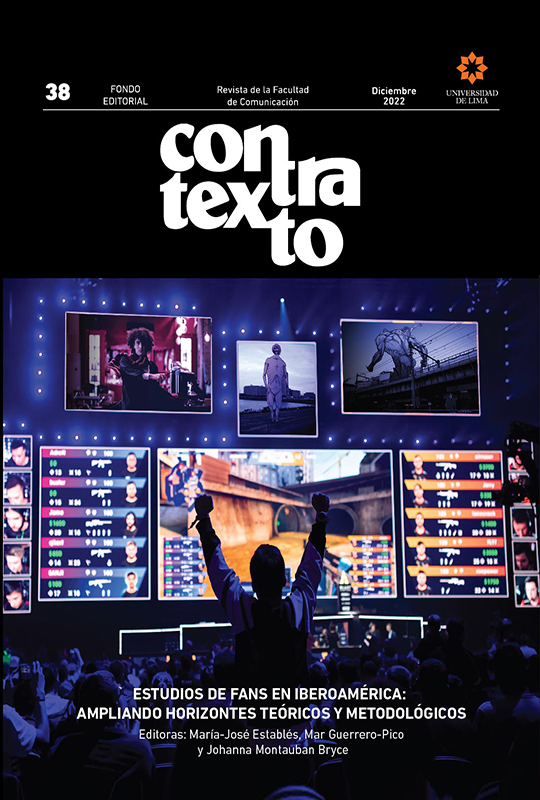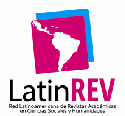The Secret History: un fandom clave de la Dark Academia
DOI:
https://doi.org/10.26439/contratexto2022.n038.5848Palabras clave:
The Secret History, fandom, Dark Academia, Tumblr, estéticaResumen
Este artículo busca realizar una primera aproximación a la comunidad estética Dark Academia, que adquirió una amplia popularidad durante la pandemia. Asimismo, se explora su relación con el fandom de la novela The Secret History (Donna Tartt, 1992). Para llevar a cabo el análisis, se estudian las prácticas ejercidas por los miembros de la Dark Academia en la red social Tumblr, seleccionada debido a sus múltiples posibilidades de circulación de contenido y sus facilidades de creación de comunidades. Además, el estudio se apoya en la metodología de la encuesta, realizada de manera virtual a 1000 usuarios de la comunidad estética. La intención es resaltar cómo el fandom de la obra de Donna Tartt es clave para el desarrollo y evolución de esta nueva comunidad.
Descargas
Referencias
Adams, T. (2013, 13 de octubre). Donna Tartt: the slow-burn literary giant. The Guardian. https://www.theguardian.com/theobserver/2013/oct/13/donna-tartt-quietamerican-profile
Aller, R. (2021). ¿Qué es ser fan? El abordaje sobre el fandom de Harry Potter en Argentina. Antropológicas, 17, 24-35.
Ardèvol, E., Estalella, A., & Domínguez, D. (Coords.). (2008). La mediación tecnológica en la práctica etnográfica. Actas del simposio en el XI Congreso de Antropología. Donosti.
Beattie, J. (1964). Other cultures. Aims, methods and achievements in social anthropology. The Free Press.
Becker, H. S. (1982). Art worlds. University of California Press.
Bennett, L. (2017). The ethics, design, and use of surveys in fan studies. En M. A. Click & S. Scott (Eds.), The Routledge Companion to Media Fandom (pp. 26-44). Routledge.
Booth, P. (2016). Digital fandom 2.0: New media studies (2.a ed.). Peter Lang.
Chu, A. (2020, 5 de noviembre). The rise of Dark Academia. The Insider. https://www.vinsider.ca/voices/the-rise-of-dark-academia/
Curran, J., Morley, D., & Walkerdine, V. (Coords.). (1998). Estudios culturales y comunicación: análisis, producción y consumo cultural de las políticas de identidad y el posmodernismo. Paidós Ibérica.
Delvigo, S. (2020). Dark Academia, la subcultura que se viralizó durante la pandemia. Bloc de Moda. http://www.blocdemoda.com/2020/12/dark-academia-subculturetik-tok-pandemia.html
Dillman, D. (2020). Towards survey response rate theories that no longer pass each other like Strangers in the Night. En P. Brenner (Ed.), Understanding survey methodology sociological theory and applications (pp. 18-25). Springer.
Fandom. (2020, 4 de diciembre). 2020’s top aesthetics. Fandom on Tumblr. https://fandom.tumblr.com/post/636605480338407424/2020-aesthetics
Fandom. (2021, 24 de noviembre). Aesthetics. Fandom on Tumblr. https://fandom.tumblr.com/post/669319516319367168/2021-aesthetics
Fiske, J. (1984). Introducción al estudio de la comunicación. Norma.
Griswold, W. (1999). Cultures and societies in a changing world. Pine Forge Press.
Grossberg, L. (2001). Is there a fan in the house? : The affective sensibility of fandom. En L. Lewis (Ed.), The adoring audience: Fan culture and popular media (pp. 50-65). Routledge.
Hallett, E. R., & Barber, K. (2014). Ethnographic research in a cyber era. Journal of Contemporary Ethnography, 43(3), 306-330. https://doi.org/10.1177/0891241613497749
Hellekson, K. (2018). The fan experience. En P. Booth (Ed.), A companion to media fandomand fan studies (pp. 65-76). John Wiley & Son.
Fernández Huerta, C., & Ortiz Marín, A. (2013). Consideraciones a la ciberetnografía: una propuesta para el estudio de las expresiones juveniles. En L. P. Marroquín & L. A. Flores (Coords.), Making of: la práctica de la investigación sociocultural (pp. 45-61). Universidad Autónoma de Baja California.
Jenkins, H. (1992a). “Strangers no more, we sing”: Filking and the social construction of the science fiction fan community. En L. Lewis (Ed.), The adoring audience: Fan culture and popular media (pp. 208-236). Routledge.
Jenkins, H. (1992b). Textual poachers: Television fans and participatory culture. Routledge.
Jenkins, H. (2018). Fandom, negotiation, and participatory culture. En P. Booth (Ed.), A companion to media fandom and fan studies (pp. 11-26). John Wiley & Sons.
Kakutani, M. (1992, 4 de septiembre). Books of The Times. Students Indulging in Course of Destruction. The New York Times. https://www.nytimes.com/1992/09/04/books/books-of-the-times-students-indulging-in-course-of-destruction.html
Kaplan, J. (1992). Smart Tartt. Vanity Fair, 55(9), 247-251, 276-277.
Kemp, S. (2021, 27 de enero). Digital 2021: The latest insights into the ‘state of digital’. We Are Social. https://wearesocial.com/uk/blog/2021/01/digital-2021-the-latestinsights-into-the-state-of-digital/
Lamerichs, N. (Ed.). (2018). Productive fandom. Intermediality and affective reception in fan cultures. Amsterdam University Press.
Liu, H., Liu, W., Yoganathan, V., & Osburg, V. S. (2021). COVID-19 information overload and generation Z’s social media discontinuance intention during the pandemic lockdown. Technological Forecasting & Social Change, 166. https://doi.org/10.1016/j.techfore.2021.120600
Mansor, N., Razak, R., Din, N., & Mohamad, Z. (2020). The affective economy and online fan communities: A case study of Johnny & Associates. En N. Suki (Ed.), Leveraging consumer behavior and psychology in the digital economy (pp. 91-105). IGI Global.
Massony, T. (2020, 16 de diciembre). 2020’s viral internet fashion aesthetics & What they reveal about you. Elite Daily. https://www.elitedaily.com/p/2020s-viral-internetfashion-aesthetics-what-they-reveal-about-you-51029839
Morley, D. (1996). Televisión, audiencias y estudios culturales. Amorrortu.
Muggleton, D. (2002). Inside subculture. The postmodern meaning of style. Berg.
Pande, R. (2018). Who do you mean by “fan?” Decolonizing media fandom identity. En P. Booth (Ed.), A companion to media fandom and fan studies (pp. 319-332). John Wiley & Sons.
Pauw, F. (1994). “If on a winter’s night a reveller”: The classical intertext in Donna Tartt’s The Secret History (Part 1). Akroterion, 39(3-4), 141-163. https://doi.org/10.7445/39-3-4-517.
Sandvoss, C., Gray, J., & Harrington, L. (Eds.). (2017). Fandom. Identities and communities in a mediated world (2.a ed.). NYU Press.
Soler Monreal, C., & Gil Leiva, I. (2010). Posibilidades y límites de los tesauros frente a otros sistemas de organización del conocimiento: folksonomías, taxonomías y ontologías. Revista Interamericana de Bibliotecología, 33(2), 361-377.
Soto, H. M. (2022). Estéticas en TikTok: entre lo histórico y lo digital. Cuadernos del Centro de Estudios en Diseño y Comunicación, 152, 199-209. https://doi.org/10.18682/cdc.vi152.6688
Staiger, J. (2005). Media reception studies. New York University Press.
Stein, L. (2015). Millennial fandom. Television audiences in the transmedia age. University of Iowa Press.
Stein, L. (2016, 25 de enero). The limits of infinite scroll: Gifsets and fanmixes as evolving fan traditions. Flow Journal. https://www.flowjournal.org/2016/01/the-limits-of-infinite-scroll-gifsets-and-fanmixes-as-evolving-fan-traditions/
Stein, L. (2018). Tumblr fan aesthetics. En M. A. Click & S. Scott (Eds.), The Routledge Companion to Media Fandom (pp. 86-97). Routledge.
Tartt, D. (1992). The Secret History. Alfred A Knopf. Tartt, D., & The Ballantine Publishing Group. (2002). Reader’s guide: Author Q&A.
Tajfel, H., & Turner, J. (1979). An integrative theory of intergroup conflict. En W. G. Austin & S. Worchel (Eds.), The social psychology of intergroup relations (pp. 33-47). Brooks/Cole.
Vander Wal, T. (2007, 2 de febrero). Folksonomy coinage and definition. VanderWal.net. https://vanderwal.net/folksonomy.html
Vintimilla-León, D., & Torres-Toukoumidis, A. (2021). COVID-19 y TikTok. Análisis de la folksonomía social. RISTI, Revista Ibérica de Sistemas e Tecnologías de la Informaçao, 39(5), 15-26.
World Health Organization. (2020, 11 de marzo). WHO Director-General’s opening remarks at the media briefing on COVID-19. https://www.who.int/director-general/speeches/detail/who-director-general-s-opening-remarks-at-the-media-briefing-oncovid-19---11-march-2020
Yeats, W. B. (1999). Autobiographies (vol. III). Scribner. YouTube Culture & Trends (2021). The rise of aesthetics. https://www.youtube.com/trends/articles/youtube-aesthetics/#:~:text=Among%20the%20most%20popular%20aesthetics,YouTube%20in%202020%20to%202021.&text=While%20identity%2Dseeking%20is%20one,a%20journey%2C%20not%20a%20destination
Publicado
Número
Sección
Licencia
Todos los trabajos publicados están sujetos a una licencia CC BY 4.0 Creative Commons (actualizado el 1 de marzo de 2021).
El contenido de la revista se puede compartir en cualquier material o formato. Asimismo, se puede adaptar, contribuir y transformar. Ambas posibilidades sólo están permitidas en la medida en que cumplan las siguientes condiciones:
- Atribución: Se debe otorgar crédito donde sea debido, proporcionar un enlace a la licencia e indicar los cambios en caso se realice alguno. Esto debe hacerse de la manera que se considere apropiada, sin sugerir que el licenciante lo promueva a usted o su uso del material.
Derechos de propiedad
Los derechos patrimoniales de Contratexto se publican bajo una licencia Creative Commons BY 4.0, lo que permite a los autores mantener los derechos patrimoniales de su obra sin restricciones.
Si un trabajo publicado en Contratexto fuera copiado, distribuido, difundido o cualquier otra actividad contemplada en la licencia antes mencionada, se deberá mencionar de manera visible y expresa al autor o autores y a la revista.
Auto-archivo
Esta revista permite y anima a los autores/as a publicar artículos enviados a la revista en sus sitios web personales o en depósitos institucionales, tanto antes como después de su publicación en esta revista, siempre y cuando proporcionen información bibliográfica que acredite, si procede, su publicación en ella.


















